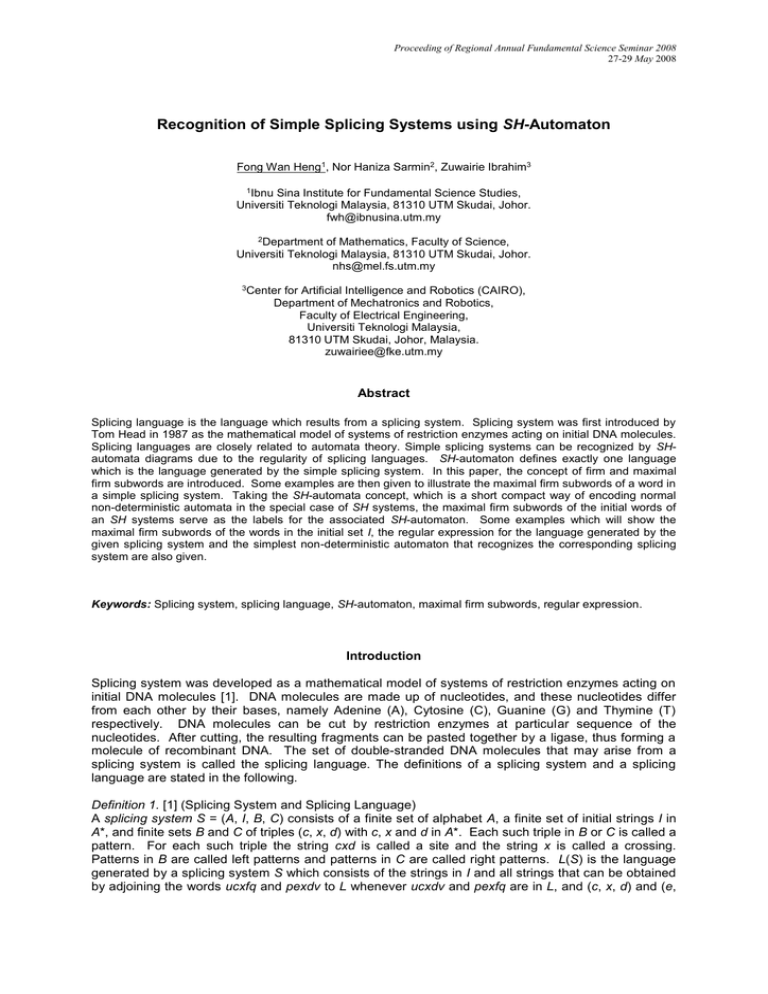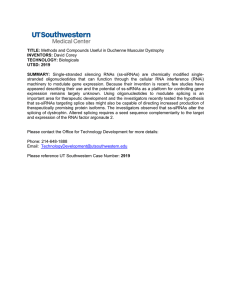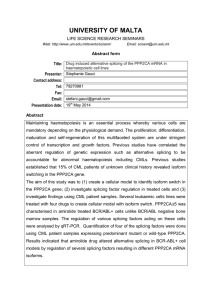RAFSS 2008 - paper Fong
advertisement

Proceeding of Regional Annual Fundamental Science Seminar 2008
27-29 May 2008
Recognition of Simple Splicing Systems using SH-Automaton
Fong Wan Heng1, Nor Haniza Sarmin2, Zuwairie Ibrahim3
1Ibnu
Sina Institute for Fundamental Science Studies,
Universiti Teknologi Malaysia, 81310 UTM Skudai, Johor.
fwh@ibnusina.utm.my
2Department of Mathematics, Faculty of Science,
Universiti Teknologi Malaysia, 81310 UTM Skudai, Johor.
nhs@mel.fs.utm.my
3Center
for Artificial Intelligence and Robotics (CAIRO),
Department of Mechatronics and Robotics,
Faculty of Electrical Engineering,
Universiti Teknologi Malaysia,
81310 UTM Skudai, Johor, Malaysia.
zuwairiee@fke.utm.my
Abstract
Splicing language is the language which results from a splicing system. Splicing system was first introduced by
Tom Head in 1987 as the mathematical model of systems of restriction enzymes acting on initial DNA molecules.
Splicing languages are closely related to automata theory. Simple splicing systems can be recognized by SHautomata diagrams due to the regularity of splicing languages. SH-automaton defines exactly one language
which is the language generated by the simple splicing system. In this paper, the concept of firm and maximal
firm subwords are introduced. Some examples are then given to illustrate the maximal firm subwords of a word in
a simple splicing system. Taking the SH-automata concept, which is a short compact way of encoding normal
non-deterministic automata in the special case of SH systems, the maximal firm subwords of the initial words of
an SH systems serve as the labels for the associated SH-automaton. Some examples which will show the
maximal firm subwords of the words in the initial set I, the regular expression for the language generated by the
given splicing system and the simplest non-deterministic automaton that recognizes the corresponding splicing
system are also given.
Keywords: Splicing system, splicing language, SH-automaton, maximal firm subwords, regular expression.
Introduction
Splicing system was developed as a mathematical model of systems of restriction enzymes acting on
initial DNA molecules [1]. DNA molecules are made up of nucleotides, and these nucleotides differ
from each other by their bases, namely Adenine (A), Cytosine (C), Guanine (G) and Thymine (T)
respectively. DNA molecules can be cut by restriction enzymes at particular sequence of the
nucleotides. After cutting, the resulting fragments can be pasted together by a ligase, thus forming a
molecule of recombinant DNA. The set of double-stranded DNA molecules that may arise from a
splicing system is called the splicing language. The definitions of a splicing system and a splicing
language are stated in the following.
Definition 1. [1] (Splicing System and Splicing Language)
A splicing system S = (A, I, B, C) consists of a finite set of alphabet A, a finite set of initial strings I in
A*, and finite sets B and C of triples (c, x, d) with c, x and d in A*. Each such triple in B or C is called a
pattern. For each such triple the string cxd is called a site and the string x is called a crossing.
Patterns in B are called left patterns and patterns in C are called right patterns. L(S) is the language
generated by a splicing system S which consists of the strings in I and all strings that can be obtained
by adjoining the words ucxfq and pexdv to L whenever ucxdv and pexfq are in L, and (c, x, d) and (e,
Proceeding of Regional Annual Fundamental Science Seminar 2008
27-29 May 2008
x, f) are patterns of the same hand. A language L is a splicing language if there exists a splicing
system S for which L = L(S).
A particular type of splicing system discussed in this paper is the simple splicing (SH) system. The
formal definitions of a simple splicing system and a simple splicing language are given in the following.
Definition 2. [2] (Simple Splicing System and Simple Splicing Language)
Let S = (A, I, R) be a splicing system in which all rules in R have the form (a, 1; a, 1), where a is in A.
Then S is called a simple splicing system. A splicing language L is said to be a simple splicing
language if L can be generated by a simple splicing system.
Splicing languages are regular, but not all regular languages are splicing languages [3]. The definition
of a regular language is given in the following.
Definition 3. [4] (Regular)
A language L is called regular if and only if there exist a deterministic finite accepter M such that L =
L(M).
For the definition of regular language, deterministic finite accepter is used instead of deterministic
finite automaton since deterministic finite automaton [5] is also known as deterministic finite accepter
in [4]. Therefore, since simple splicing languages are regular, they can be recognized by automata
diagrams. Labels for an SH-automaton are actually the maximal firm subwords of a word. In the next
section, the concepts of firm and maximal firm subwords of a word are discussed.
Maximal Firm Subwords
For the simple splicing language L we say that a word w in L is firm if it contains no occurrence of a
letter in the rule set R. Recall that by a factor of a word w in A* meant any word y, there are words x
and z for which w = xyz, where x, z in A*. So a maximal firm subword of a word w should be a factor y
of w in which no letter in R occurs in y but if w = uayz with a in A, then a is in R and if w = xybv with b
in A, then b is in R.
If w = uayz and a is not in R, then ay would be a firm factor of w that is one letter longer than y and so
y would not be a maximal firm subword of w. If w = xybv and b is not in R, then yb would be a firm
factor of w that is one letter longer than y and so y would not be a maximal firm subword of w. A word
y is a maximal firm subword of w as long as y can get, and stay, inside w. In other words, a maximal
firm subword of w is the longest possible factor of w that contains no letter in R.
A word w in A* that contains no letter in R cannot be cut at all, thus it is considered to be firm. If w =
xry with neither x nor y null then w can be cut into two pieces and should therefore be not firm. For
simple splicing languages, a word w is firm if and only if it contains no element of R.
Some examples to illustrate the maximal firm subwords of a word in a simple splicing system are given
next. They differ in terms of the number of rules and initial strings involved. Example 1 involves a
splicing system with only one rule with the initial set I left unspecified.
Example 1
Let A = {a, b}, B = {b}, I will be left unspecified. There is only one rule, namely r = (b, λ, b, λ). A word
w in A* is firm with respect to r if (and only if) w is in a*. The maximal firm subwords of the word
aabaaabaaba are indicated via underscores: aabaaabaaba.
In the next example, maximal firm subwords of a word in a splicing system having two rules with initial
set I unspecified are given.
Example 2
Let A = {a, b, c, d, e}, B = {b, d}, I will be unspecified. There are only two rules, namely r = (b, λ, b, λ )
and r' = (d, λ, d, λ). These two rules can be abbreviated as b and d respectively. A word w in A* is
firm with respect to r if w in {a, c, d, e}*. A word w in A* is firm with respect to r' if w in {a, b, c, e}*. A
Proceeding of Regional Annual Fundamental Science Seminar 2008
27-29 May 2008
word w in A* is firm with respect to R = {r, r'} if and only if w is in {a, c, e}*. The maximal firm subwords
of the word aabacadcccbceeab are indicated via underscores: aabacadcccbceeab.
Example 3 and Example 4 show the maximal firm subwords of words in a splicing language L
generated by a splicing system involving a specified set I, one and two rules respectively. The
language generated is listed in recursive form and the maximal firm subwords of words in that
language are indicated via underscores.
Example 3
Let A = {a, b}, B = {b} and I = {aaabaa, aba}. The language generated by (A, B, I) is L = {aaabaa, aba,
aaaba, abaa}. The maximal firm subwords of words in L are indicated via underscores: aaabaa, aba,
aaaba, abaa.
Example 4
Let A = {a, b, c, d, e}, B = {b, d} and I = {aabcedccbee}. The language generated by (A, B, I) is L' =
{aab(cedccb)*ee}. The maximal firm subwords of words in L' are indicated via underscores: aab(ced
ccb)*ee.
Example 5 involves a more complicated splicing system involving two rules and two initial strings.
Example 5
Let A = {a, b, c, d, e}, B = {b, d} and I = {abcde, edcba}. The language generated by (A, B, I) is L'' =
{a(bcdc)*ba, e(dcbc)*de, a(bcdc)*bcde, e(dcbc)*dcba}. The maximal firm subwords of words in L'' are
indicated via underscores: a(bcdc)*ba, e(dcbc)*de, a(bcdc)*bcde, e(dcbc)*dcba.
In order to visualize and represent finite automata, transition diagrams which involve vertices and
edges are used [4]. An automaton recognizes a language L if each string accepted by the automaton
is in L and each string in L is accepted by the automaton [6]. The simple splicing automata (SHautomata) concept is explained in the following.
SH-automata Concept
Taking the SH-automata concept, which is a short compact way of encoding normal non-deterministic
automata in the special case of SH systems, the maximal firm subwords of the initial words of an SH
systems serve as the labels for the associated SH-automaton.
One trip through the SH-automaton is an arbitrary walk through the graph entering via an entrance
following any path until exit. The language is an infinite set. We can generate a lot of different words
from an SH-automaton, but SH-automaton defines exactly one language which is exactly the language
generated by the simple splicing system.
Some examples are given in the following which will show the maximal firm subwords of the words in
the initial set I, the regular expression for the language generated by the given splicing system and the
simplest non-deterministic automaton that recognizes the corresponding splicing system. The
examples differ in the number of initial strings and rules involved.
Example 6 involves a splicing system with only one string in I and one rule in R.
Example 6
Suppose A = {a, b}, I = {aabaaaaabaaabaa} and R = {b}. The maximal firm subwords of the only word
in I are aa, aaaaa, aaa. The regular expression for this language is aab(aaab+aaaaab)*aa. The
simplest non-deterministic automaton that recognizes L (A, I, R) is given in Figure 1.
Proceeding of Regional Annual Fundamental Science Seminar 2008
27-29 May 2008
Figure 1: Automaton for Example 6
Example 7 involves a splicing system with two strings in I and one rule in R.
Example 7
Suppose A = {a, b}, I = {abaaabaaabaa, aabaaaaabaaaaabaaaaa} and R = {b}. The maximal firm
subwords of I are a, aaa, aa, aaaaa.
The regular expression for this language is
(a+aa)b(aaab+aaaaab)*(aa+aaaaa). Notice that we will get the same language generated if I were
{abaaabaa, aabaaaaabaaaaa} or if I were {abaaaaa, aabaaaaabaaabaa}. The simplest nondeterministic automaton that recognizes L (A, I, R) is given in Figure 2.
Figure 2: Automaton for Example 7
The following example involves a splicing system with two strings in I and also two rules in R.
Example 8
Suppose A = {a, b, c}, I = {abaacaaaaaba, abaaabaaacaaba} and R = {b, c}. The maximal firm
subwords of I are a, aa, aaaaa, aaa.
The regular expression for this language is
ab[aaab+(aac+aaac)(aab+aaaaab)]*a. The simplest non-deterministic automaton that recognizes L
(A, I, R) is shown in Figure 3.
Figure 3: Automaton for Example 8
Example 9 involves a splicing system with one string in I and one rule in R, where the symbols in R
may appear adjacent to each other in I.
Example 9
Suppose A = {a, b}, I = {abaaabbaabbba} and R = {b}. The maximal firm subwords of I are a, aaa, aa.
The regular expression for this language is ab(aaab+b+aab)*a. Note that (a+b)* = A*; a*b* are those
words in which all occurrences of an ‘a’ come before all occurrences of ‘b’. The simplest nondeterministic automaton that recognizes L (A, I, R) is given in Figure 4.
Proceeding of Regional Annual Fundamental Science Seminar 2008
27-29 May 2008
Figure 4: Automaton for Example 9
Therefore, simple splicing systems can be recognized by SH-automaton using transition diagrams as
illustrated in this section.
Conclusion
In this paper, the concept of maximal firm subwords is introduced. The maximal firm subwords of the
initial words of a simple splicing system are shown to serve as the labels for the associated SHautomaton. Also, SH-automaton defines exactly one language which is exactly the language
generated by the simple splicing system.
Acknowledgements
We would like to express our gratitude to Prof. Tom Head from State University of New York at
Binghamton, Binghamton, New York, USA, for his collaboration in this research. We would also like to
thank the Ministry of Science, Technology and Innovation (MOSTI) Malaysia and the Research
Management Centre (RMC), UTM for the financial funding through e-Science Fund Vote No 79081.
References
1.
2.
3.
4.
5.
6.
T. Head, Formal Language Theory and DNA: An Analysis of the Generative Capacity of Specific
Recombinant Behaviors, Bulletin of Mathematical Biology 49, (1987) 737-759.
E. G. Laun, Constants and Splicing Systems, Ph.D. Thesis, State University of New York at
Binghamton, 1999.
R. W. Gatterdam, Splicing Systems and Regularity, International Journal of Computer Math 31,
(1989) 63-67.
P. Linz, An Introduction to Formal Languages and Automata, 3rd. ed. USA: Jones and Bartlett
Publishers Inc., 2001.
D. Kelley, Automata and Formal Languages, USA: Prentice-Hall Inc, 1995.
M. V. Lawson, Finite Automata, USA: Chapman & Hall/CRC, 2004.


